I’m excited to share my easy homemade sauerkraut recipe with you. This traditional fermented cabbage dish is full of natural probiotics. These probiotics can greatly improve your digestive system and overall health.
Sauerkraut has been a favorite in many cultures for centuries. It’s because of the lacto-fermentation process. This process turns ordinary cabbage into a rich source of beneficial bacteria, vitamins, and minerals. Making sauerkraut at home lets you enjoy its health benefits anytime.
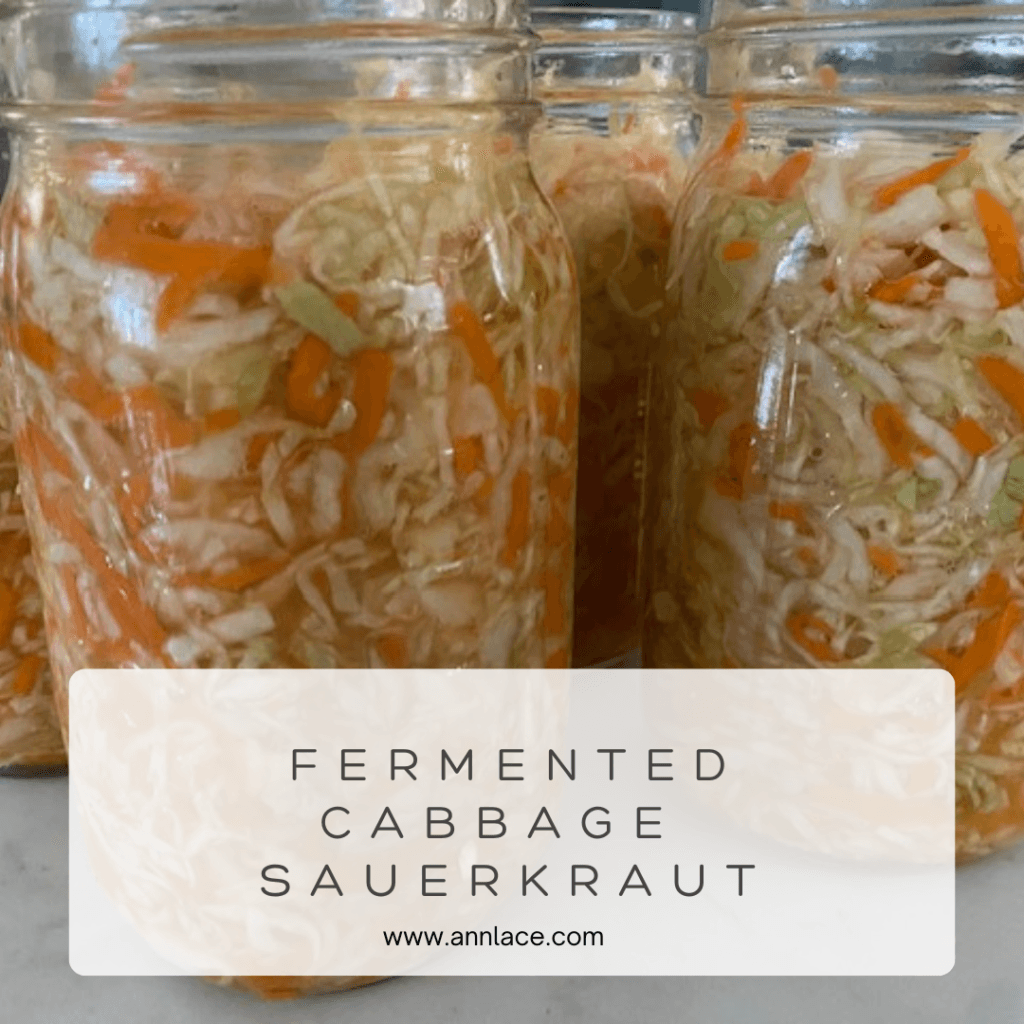
A rustic kitchen scene featuring a glass jar filled with vibrant shreded cabbage with grated carrots, surrounded by fresh ingredients like green cabbage, sea salt, and spices. Soft natural lighting enhances the textures, with wooden utensils and fermentation tools scattered around. A hint of probiotic culture in a small bowl adds to the composition.
Key Takeaways
- Homemade sauerkraut is packed with natural probiotics to support gut health
- The fermentation process transforms cabbage into a nutrient-dense food
- Sauerkraut can improve digestion and boost the immune system
- It’s easy to make sauerkraut at home with just a few simple ingredients
- Sauerkraut can be enjoyed as a healthy condiment or incorporated into various recipes
What is Sauerkraut?
Sauerkraut is a traditional fermented cabbage dish from Europe. It’s made by shredding cabbage and mixing it with salt. This mixture ferments, creating probiotic bacteria like lactobacillus.
A Flavorful Fermented Delight
The fermentation turns cabbage into a tangy, crunchy treat. It’s full of probiotics, vitamins, and nutrients. Sauerkraut is a favorite for its taste and health benefits.
Gut-Friendly Nutrition
Sauerkraut is known for its health perks. The probiotic bacteria in it help keep the gut and immune system healthy. Adding sauerkraut to your meals can boost your overall health.
“Sauerkraut is a true testament to the power of traditional fermented foods and their ability to nourish our bodies from the inside out.”
Benefits of Sauerkraut for Gut Health
Eating sauerkraut can greatly benefit your gut health. It’s a fermented food full of probiotics. These help with digestion and boost your immune system.
Supports Healthy Digestion
Sauerkraut contains gut-friendly bacteria like Lactobacillus. These probiotics are key to a balanced gut. They help break down food and improve nutrient absorption. This leads to regular bowel movements and better digestion.
Boosts Immune System Function
The gut is linked closely to the immune system. The probiotics in sauerkraut strengthen the gut’s barrier. They also support immune cells. This makes your immune system stronger, helping you fight off infections and illnesses.
| Probiotic Benefit | Description |
|---|---|
| Digestive Support | Probiotics in sauerkraut help break down food, improve nutrient absorption, and promote regular bowel movements. |
| Immune System Boost | The gut-friendly bacteria in sauerkraut strengthen the gut’s protective barrier and support the activity of immune cells. |
“Sauerkraut is a powerhouse of gut-supporting probiotics that can have a far-reaching impact on your overall health and well-being.”
Adding sauerkraut to your diet regularly can bring many benefits. It supports gut health, digestive function, and immune system support. This fermented food is easy to add to your meals and helps nourish your gut microbiome.
Sauerkraut recipe Natural Probiotics for your gut health
Homemade sauerkraut is a great way to add natural probiotics to your diet. My easy sauerkraut recipe lets you ferment cabbage at home. This way, you can enjoy the many benefits of this probiotic-rich food.
The secret to tasty, gut-friendly sauerkraut is fermentation. This process lets the natural lactobacillus bacteria grow. They turn simple cabbage into a probiotic powerhouse that feeds your digestive system.
“Sauerkraut is a true powerhouse of gut-friendly probiotics, and making it at home is incredibly satisfying. Give this recipe a try and witness the transformative effects on your digestive health.”
Ingredients for Homemade Sauerkraut
Making homemade sauerkraut is easy, needing just a few things. The main ingredient is cabbage, which can be green or red. You also need sea salt for the fermentation process.
Green or Red Cabbage
You can pick between green or red cabbage for your sauerkraut. Both will give you tasty, probiotic-rich sauerkraut. Green cabbage is milder and sweeter. Red cabbage adds a beautiful color and a stronger taste.
Sea Salt and Water
You’ll also need sea salt and water for the brine. The salt pulls moisture from the cabbage, helping the good bacteria grow. The water keeps the cabbage under the brine during fermentation.
| Ingredient | Quantity |
|---|---|
| Green or Red Cabbage | 1 medium head (about 2 lbs) |
| Sea Salt | 1-2 tablespoons |
| Water | Enough to cover the cabbage |
With these simple ingredients, you can start making your own homemade sauerkraut. Enjoy the tasty benefits of this natural way to preserve food.
Step-by-Step Instructions
Making homemade sauerkraut is easy and lets you enjoy a probiotic-rich dish at home. Just follow these simple steps to make a traditional, fermented cabbage dish. You’ll learn how to naturally preserve and ferment cabbage.
You do not need any special equipment to fermented cabbage. But if you will do it you regularly I would recommend to invest in cabbage grater and glass weights.
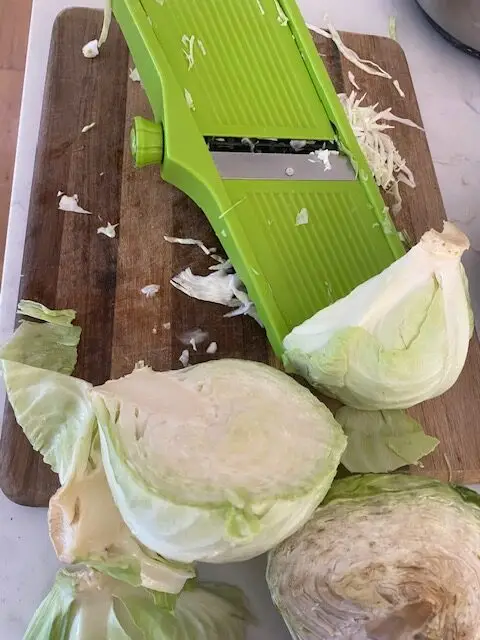
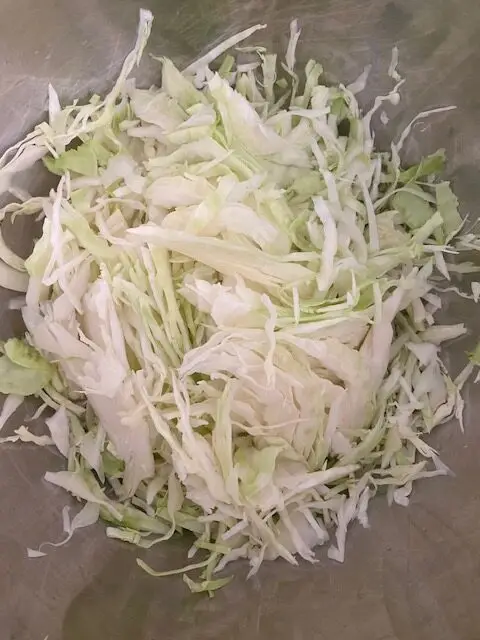
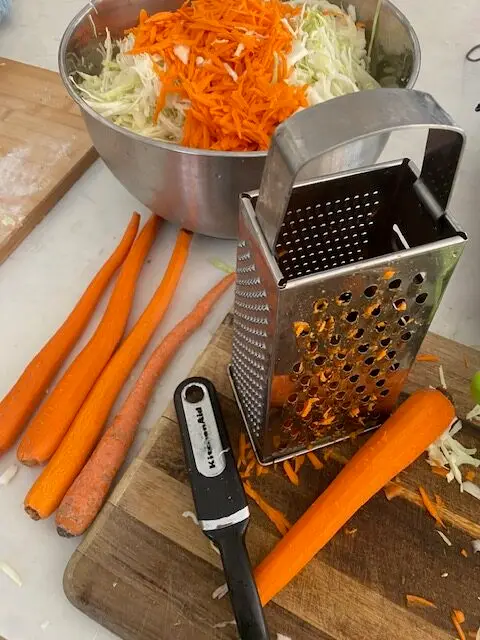
- Prepare the Cabbage: Choose a fresh, crisp cabbage head. Remove outer leaves and shred it thin using cabbage grater. If you do not have cabbage grater you can slice it thin with knife.
- Pill carrots and shred them in grator.
- Put shredded cabbage and carrots to a big mixing bowl.
- Add salt and sugar to the mixing bowl.
- Add water to the bowl and mix all ingredients together
- Massage and squeeze everything with your hands. This helps the cabbage and carrots to release juices.
- Put prepared mixture to the canning jars. Push it down, It should be covered by juices released from massaging. If you have weighted lids put them on top of the cabbage. If not, Just make sure mixture is pressed down and covered by liquid.
- Put prepared mixture to the jars and cover them with lids, but do not tight them, leave room for air. Or you can cover with piece of fabric and tight it with rubber band. This allows air to flow in and out of the jar, but prevents dust or insects from getting into the jar.
- Keep the sauerkraut away from direct sunlight and at a cool room temperature. Leave Jars on counter top for 3-5 days. If you like it be very sour you can wait longer. But It should be ready after day 3.
- Every day poke the sauerkraut with wood stick, or fork, It will release some air bubbles which is helps fermentation process. Also press down shredded vegetables if they float, they should be underneath the liquid.
- When you like the taste after 3-5 days, put regular lid to the mouth of the jar and store it in refrigerator.
- Sauerkraut can be stored in refrigerator up to 4 months. Always taste it and smell before eating.
By following these steps, you can make your own delicious sauerkraut. It’s full of natural probiotics and keeps the cabbage’s nutrients through fermentation.
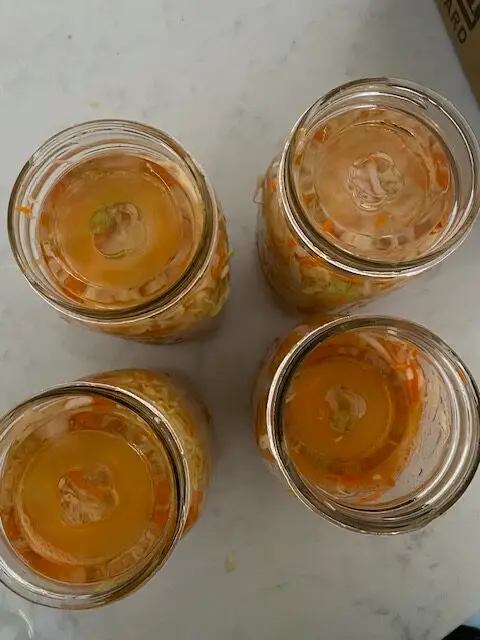
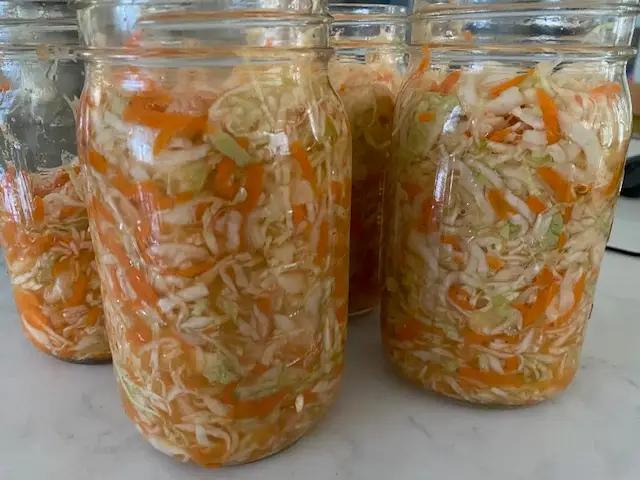
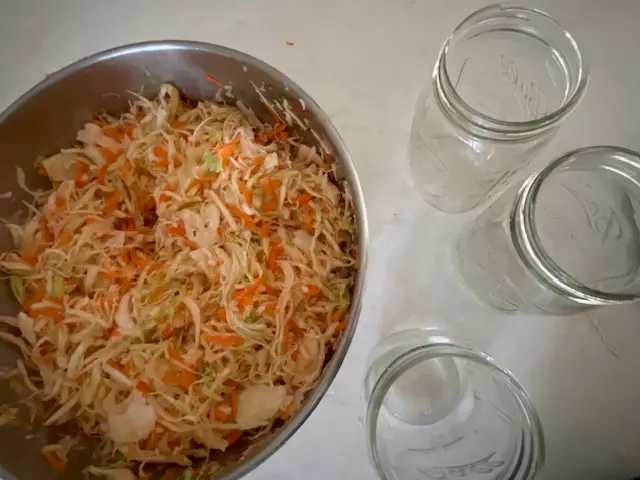
Fermentation Process Explained
The fermentation process is the heart of making sauerkraut tasty and full of probiotics. Lactobacillus bacteria turn cabbage’s sugars into lactic acid. This makes sauerkraut tangy and adds good bacteria for your gut.
Lactobacillus and Lactic Acid
Lactobacillus bacteria are key in sauerkraut fermentation. They grow in the cabbage’s saltwater brine, eating its sugars. This makes lactic acid, which gives sauerkraut its sour taste and keeps it fresh.
This process makes sauerkraut not just tasty but also full of nutrients. It makes these nutrients easier for your body to use. By learning about this, you can make your own sauerkraut full of natural probiotics for a healthy gut.
A vibrant, detailed illustration of the fermentation process for sauerkraut, showcasing a glass jar filled with finely shredded cabbage submerged in brine, bubbles forming as natural fermentation occurs, surrounded by fresh ingredients like cabbage leaves, a salt bowl, and spices, depicted in a warm kitchen setting with soft light highlighting the transformation from raw ingredients to tangy probiotic-rich sauerkraut.
“Fermentation is the key to unlocking the hidden superpowers of sauerkraut – transforming humble cabbage into a gut-nourishing powerhouse.”
Troubleshooting Tips
Making your own homemade sauerkraut can be rewarding, but you might face some minor issues. Don’t worry, I’ve got some helpful tips to help your fermentation process go smoothly. Your sauerkraut will turn out perfectly every time.
Identifying and Preventing Mold
One common worry when making homemade sauerkraut is mold. It can be hard to spot, but there are signs to look for:
- White, fuzzy patches on the sauerkraut
- A slimy or slick fermentation texture
- An unpleasant, musty smell from the jar
If you see these signs, don’t panic! To prevent mold, make sure your sauerkraut stays under the brine. Use a weight to keep the cabbage down. You can also add more salt to the brine to stop mold.
“The key to preventing mold is to ensure your sauerkraut is always submerged in the brine.”
If you find mold, just remove it and throw away the affected part. The rest of your sauerkraut should be safe to eat, as long as the mold hasn’t spread too far.
With a little troubleshooting and care, your homemade sauerkraut will always be a hit. Follow these tips to make a delicious, probiotic-rich condiment that will impress everyone.
Serving and Storing Sauerkraut
After your homemade sauerkraut is fermented, it’s ready to enjoy. Just scoop out what you want and use it as a tasty condiment or side. It goes well with many dishes, like pork or sausages. You can also add it to sandwiches or hot dogs for a healthy twist.
To keep your sauerkraut fresh, store it in an airtight container in the fridge. This keeps it fresh for months. Freezing it is another option, but it might slightly reduce the probiotics.
Tips for Serving and Storing Homemade Sauerkraut:
- Scoop out desired amount and serve as a condiment or side dish
- Pairs well with pork, sausages, sandwiches, and more
- Store in an airtight container in the refrigerator for 3-6 months
- Can be frozen for longer-term storage, though may reduce probiotics slightly
- Avoid exposing sauerkraut to air, which can cause it to lose its probiotic benefits and develop an unpleasant taste
Follow these tips to enjoy your homemade sauerkraut for months. Always store it right to keep its probiotics and flavor.
Variations and Flavor Combinations
Homemade sauerkraut is delicious on its own, but it’s even better with different flavors. You can add spices and herbs to make it your own. This way, you can create unique tastes that excite your taste buds.
Spices and Herbs to Try
Try these spices and herbs in your sauerkraut:
- Caraway seeds – They give a unique earthy flavor.
- Dill – Fresh or dried, it pairs well with sauerkraut’s tartness.
- Garlic – Minced or crushed, it adds a savory taste.
- Juniper berries – They have a piney flavor that’s a bit peppery.
- Fennel seeds – They add a licorice-like taste that goes well with cabbage.
- Turmeric – It’s not just for color; it also has health benefits.
Don’t stop there. Try fresh herbs like thyme, rosemary, or chili pepper for a spicy touch. The choices are endless when you customize your sauerkraut.
| Spice/Herb | Flavor Profile | Suggested Quantity |
|---|---|---|
| Caraway seeds | Earthy, slightly anise-like | 1-2 teaspoons per quart of sauerkraut |
| Dill | Fresh, herbal | 2-3 tablespoons, fresh or dried, per quart |
| Garlic | Savory, pungent | 2-3 cloves, minced or crushed, per quart |
| Juniper berries | Piney, slightly peppery | 5-10 berries per quart |
| Fennel seeds | Licorice-like | 1-2 teaspoons per quart |
| Turmeric | Earthy, vibrant color | 1/2 teaspoon per quart |
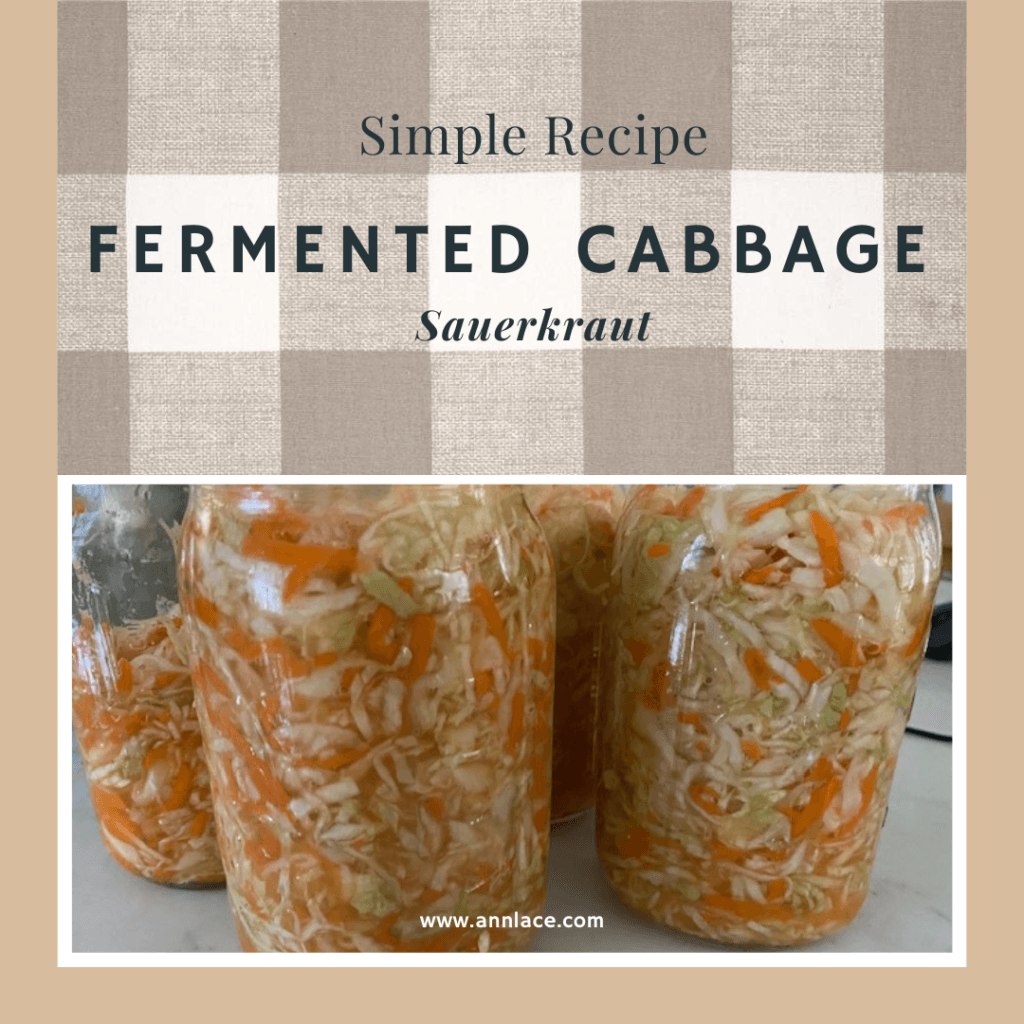
A rustic wooden kitchen table adorned with a large glass jar of vibrant homemade fermented grated cabbage, showcasing its rich, fermented colors of green and purple, surrounded by fresh ingredients like cabbage, carrots, and spices, with a soft natural light illuminating the scene for a warm, inviting atmosphere.
“Sauerkraut is a blank canvas, waiting to be painted with the flavors of your imagination.”
Sauerkraut as a Healthy Condiment
Sauerkraut is more than just a tasty dish; it’s a nutritious condiment. It can make many meals better. By adding this sauerkraut to your food, you get lots of gut health benefits and natural probiotics.
Using sauerkraut as a topping or side is a great idea. It adds a tangy flavor and crunchy texture to sandwiches, hot dogs, burgers, and salads. Just a few tablespoons of homemade sauerkraut can help your body digest food better and boost your immune system.
Sauerkraut is also great in dips, spreads, and baked dishes like casseroles or quiches. It’s a versatile ingredient that can be used in many ways to add probiotics to your meals.
So, when you want to improve your meal’s gut health, grab some sauerkraut. It’s good for your taste buds and your digestive system. Your body will appreciate it!
Incorporating Sauerkraut into Your Diet
Sauerkraut is a versatile fermented food that supports gut health. It can be added to meals from breakfast to dinner. This way, you can enjoy its natural probiotics and benefits.
Recipes and Meal Ideas
Here are some tasty ways to use sauerkraut for better gut health:
- Start your day with a sauerkraut breakfast bowl. Mix it with scrambled eggs, avocado, and whole grain toast for a nutritious and satisfying meal.
- Add a spoonful of sauerkraut to your favorite sandwich or wrap. The tangy flavor pairs well with deli meats, cheese, and crunchy vegetables.
- Enjoy sauerkraut as a tasty topping on grilled bratwurst or hot dogs. The probiotics and tanginess complement the savory flavors perfectly.
- Stir sauerkraut into soups, stews, or chilis for an extra boost of gut-friendly nutrients.
- Mix sauerkraut into your favorite dips or spreads, such as hummus or tzatziki, for a probiotic-rich snack.
- Serve sauerkraut as a side dish alongside roasted meats, fish, or vegetarian main courses.
| Meal Idea | Sauerkraut Serving Suggestion |
|---|---|
| Breakfast Bowl | Mix with scrambled eggs, avocado, and whole grain toast |
| Sandwich or Wrap | Add as a topping with deli meats, cheese, and veggies |
| Grilled Bratwurst or Hot Dogs | Serve as a savory condiment |
| Soups, Stews, and Chilis | Stir into the dish for a probiotic boost |
| Dips and Spreads | Mix into hummus, tzatziki, or other favorite dips |
| Side Dish | Serve alongside roasted meats, fish, or vegetarian entrees |
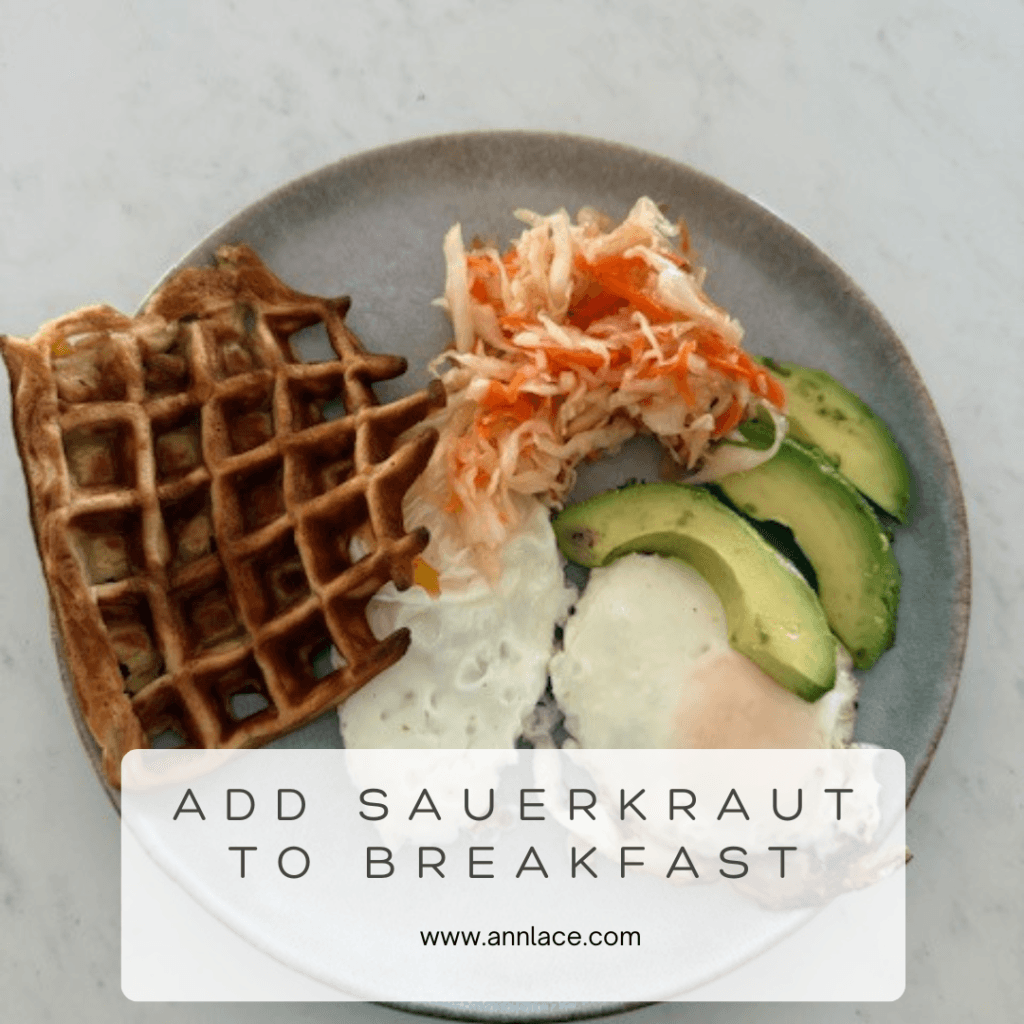
Adding sauerkraut to your diet can bring natural benefits. It supports your gut health and overall well-being.
Gut Health and the Microbiome
The gut microbiome is a huge community of bacteria and other microorganisms in our digestive tract. It’s key to our health and well-being. Eating probiotic-rich foods like sauerkraut can bring many benefits, such as better digestion and a stronger immune system.
Our gut health is closely tied to the microbes in our intestines. These tiny beings, known as the gut microbiome, do many important jobs. They help digest nutrients, keep us safe from harmful germs, and even affect our mood and thinking.
When the gut microbiome is not balanced, it can cause health problems. Issues like digestive issues, weak immunity, and mental health problems can stem from an imbalance. That’s where sauerkraut, a fermented cabbage dish full of probiotics, comes in.
Sauerkraut is packed with live, active cultures of Lactobacillus bacteria. These are crucial for a healthy gut. Eating sauerkraut regularly can help balance your gut microbiome. This supports good digestion, strengthens your immune system, and may even boost your mood and brain function.
Adding sauerkraut to your diet is a tasty way to care for your gut and enjoy the benefits of a healthy microbiome. You can enjoy it as a condiment or mix it into your favorite meals. Sauerkraut is a great friend in the quest for overall gut health.
Probiotic Benefits Beyond Digestion
Probiotics in foods like sauerkraut do more than help with digestion. They also boost your immune system, improve mood, and support skin health. Let’s look at how sauerkraut and its probiotics can enhance your health and wellness.
Immunity, Mood, and More
Studies show that sauerkraut’s probiotics strengthen your immune system. This makes you less likely to get sick. The gut and brain are connected, and a healthy gut can make you feel happier and more focused.
Also, sauerkraut’s good bacteria can make your skin clearer and healthier. This is because they reduce inflammation and keep your skin’s pH balanced.
Eating sauerkraut and other probiotic foods can greatly benefit your health. It’s not just for your stomach. It supports your immune system, mental health, and skin. Sauerkraut is a fantastic fermented food to add to your diet.
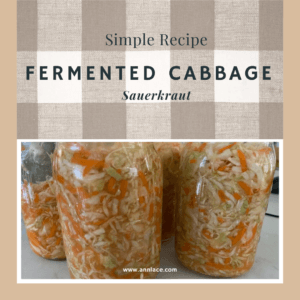
Homemade Sauerkraut
Equipment
- 1 Cabbage Grater,
- 1 Grater
- 2 canning jars
- 2 glass weights lids for fermenting optional
Ingredients
- 1 cabbage
- 2 big carrots
- 2 tbsp salt
- 1 tbsp sugar
- 2 tbsp water
Instructions
- Prepare the Cabbage: Choose a fresh, crisp cabbage head. Remove outer leaves and shred it thin using cabbage grater. If you do not have cabbage grater you can slice it thin with knife.
- Pill carrots and shred them in grator.
- Put shredded cabbage and carrots to a big mixing bowl.
- Add salt and sugar to the mixing bowl.
- Add water to the bowl and mix all ingredients together
- Massage and squeeze everything with your hands. This helps the cabbage and carrots to release juices.
- Put prepared mixture to the canning jars. Push it down, It should be covered by juices released from massaging. If you have weighted lids put them on top of the cabbage. If not, Just make sure mixture is pressed down and covered by liquid.
- Put prepared mixture to the jars and cover them with lids, but do not tight them, leave room for air. Or you can cover with piece of fabric and tight it with rubber band. This allows air to flow in and out of the jar, but prevents dust or insects from getting into the jar.
- Keep the sauerkraut away from direct sunlight and at a cool room temperature. Leave Jars on counter top for 3-5 days. If you like it be very sour you can wait longer. But It should be ready after day 3.
- Every day poke the sauerkraut with wood stick, or fork, It will release some air bubbles which is helps fermentation process. Also press down shredded vegetables if they float, they should be underneath the liquid.
- When you like the taste after 3-5 days, put regular lid to the mouth of the jar and store it in refrigerator.
- Sauerkraut can be stored in refrigerator up to 4 months. Always taste it and smell before eating.
Notes
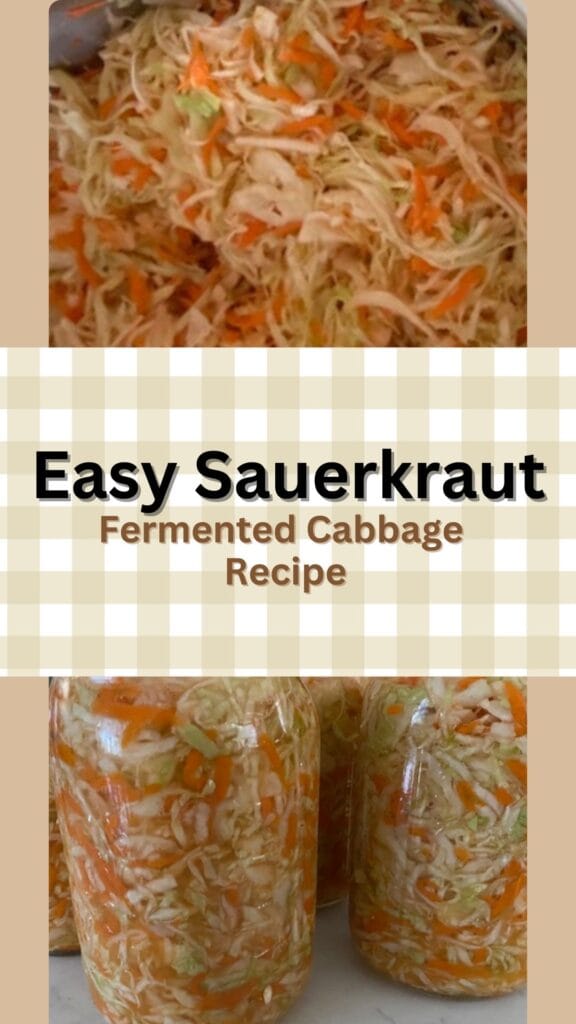

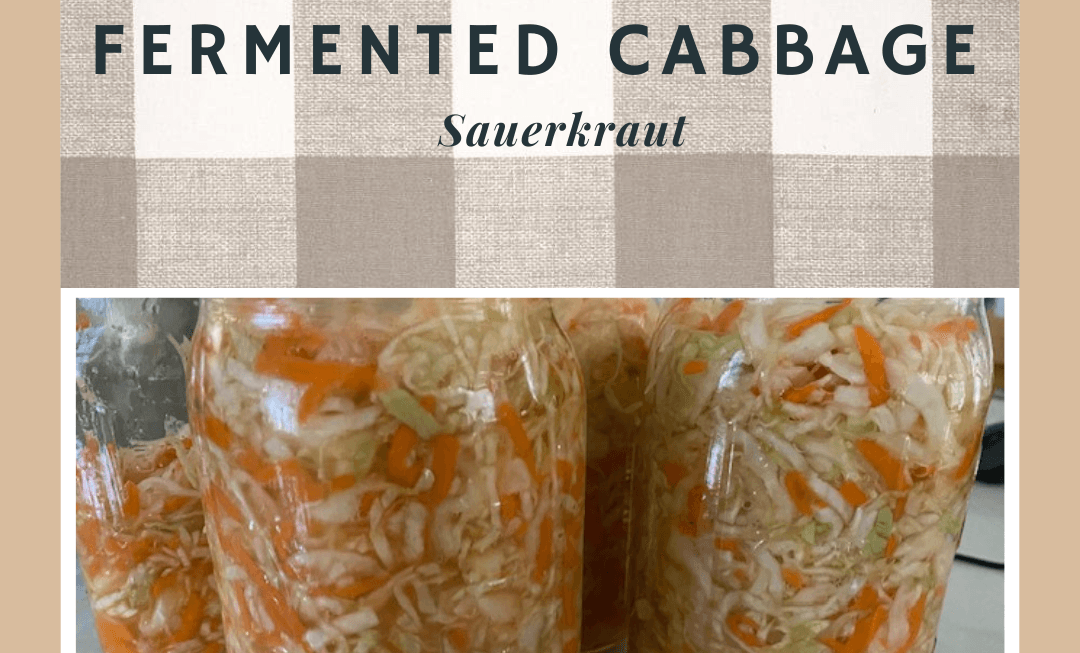



It’s delicious! Thank you!